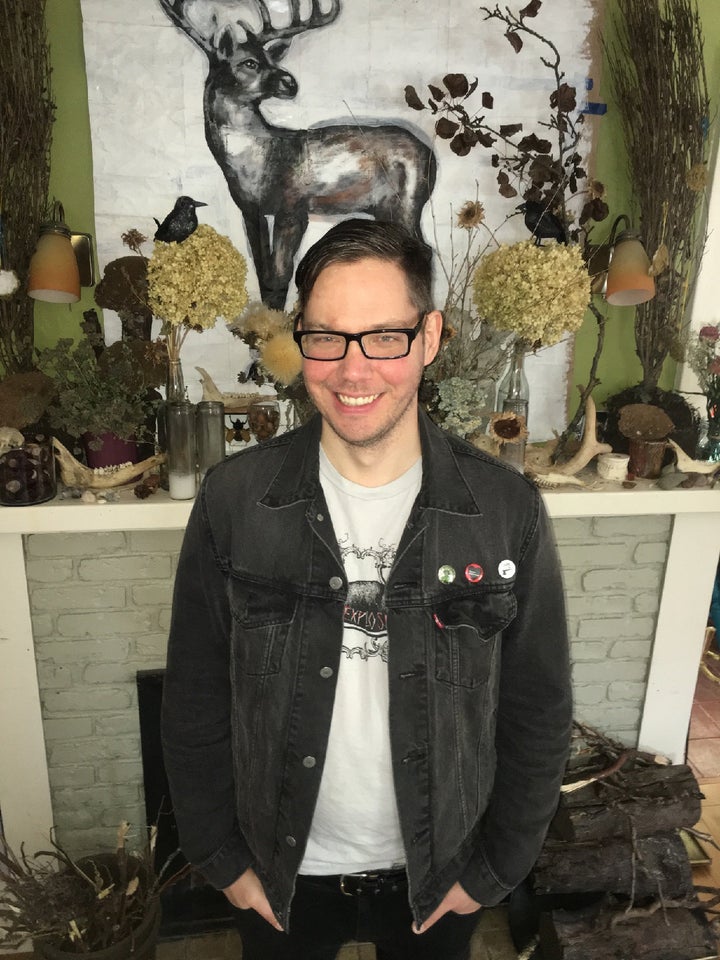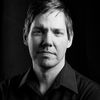
I’m a freelance illustrator and graphic designer. I’ve made art my entire life ― paintings, illustrations, album covers, comics, fanzines, novels. People seek me out to create something for them, and I’ve got a client list that I’m profoundly proud of.
The thing is, I’m an illustrator and graphic designer, but I’m also a legally blind illustrator and graphic designer.
I was born with optic nerve hypoplasia, or ONH, which is essentially the deadening or lack of development of the optic nerve during gestation. ONH is one of the three most common causes of visual impairments in children. In my case, ONH resulted in a severe lack of peripheral vision. While most people are born with a 180-degree peripheral field, I’ve got a roughly 25-degree field with both eyes combined. This is what most people refer to as tunnel vision.
It means that I sometimes walk with a red-tipped cane, and I’m regularly taken out by periphery-testers like cupboard doors and fire hydrants. It means I will always, always come across as an asshole because I will never see it when you offer to shake my hand. I’ll never even be able to see your entire face when you speak ― while I’m watching your mouth move, I’m not able to see your eyes. That’s the kind of restricted visual field we’re talking about.
“I sometimes walk with a red-tipped cane, and I’m regularly taken out by periphery-testers like cupboard doors and fire hydrants ... I will never see it when you offer to shake my hand.”
It also means that when I’m working, I can’t see the entire piece of paper that I’m drawing on. I can’t see the entirety of my computer screen. It means that I have to run my eyes quickly and ceaselessly around the screen or the piece of paper and then memorize where the various lines are and how they meet up. My old visual aid instructor in high school called this “scanning,” and it’s something I’ve done my entire life. It’s innate and automatic at this point; I do it quickly and constantly, all day long. I do it with my visual work. I do it when I’m writing, cooking, talking to someone or walking down the street. It’s a way of internally mapping out and memorizing my world.
And honestly, I’m usually pretty successful at it. Given the right environment ― one free of handshakes, fire hydrants, open dishwashers, etc. ― you probably wouldn’t even know I’m disabled. At least until I eventually plow into something or miss some other cue that fully sighted people navigate without a thought. There are times when living with ONH is wildly frustrating ― threading through crowded, chaotic places like airports or concerts or even restaurants can be a maelstrom of tension, willfulness and perseverance. As a result, I’ve grown much more reliant on using my cane as a signifier of my disability.
Clocking my head into the same cupboard for the fifth time is no fun. Nearly getting clipped by a car that’s trying to eke past me while I ford a crosswalk ― a car that I could’ve sworn wasn’t there seconds ago ― is always scary as hell. There are a great number of peripheral obstacles in the world when your world’s pinhole-small.
And yet it hasn’t stopped me from doing what I love. I was born with ONH, but didn’t fully understand its severity until I was a young kid ― at which point I was already enmeshed in making art, reading comic books and drawing constantly. I was always encouraged in my creative endeavors (at least until my grades suffered because I was too busy copying panels from X-Men back issues). When I was a teenager and young adult, my mom resolutely cheered me on. There was never any suggestion that I couldn’t do these things, or that art was only for sighted people. I never experienced that. My drawings were always hung with pride. My grandparents bought me a wildly (too) expensive portfolio when I was accepted into art school. My extended family traveled across the state to see my first solo painting exhibit.
Any notion of being held back by my disability has always been internal, and it’s something that I continually battle with. It’s a constant tightrope between being immensely proud of my work in spite of my disability and also trying to accept the fact that I’m simply working from a deficit and always will be. I continually have to work on acceptance; while my disability might actually offer me a wholly unique, somewhat odd style, it also means that I’ll never truly get perspective down. I can literally only see inches of paper at once; my art will always be strangely flattened, will always look a little off. It has its limits, and it always will.
“It’s a constant tightrope between being immensely proud of my work in spite of my disability and also trying to accept the fact that I’m simply working from a deficit and always will be.”
So the majority of my stuff is highly stylized. Single-panel, single-plane. A figure or two on a flattened panel, or one with very little perspective in the background. As someone who can only see very little physical perspective, portraying an object with any accurate depth has always been immensely difficult.
Try looking through a pair of eyeglasses with each lens the size of, say, a bottle cap. That’s it, that’s all there is. There’s nothing else there, just a visual field the size of two bottle caps. That’s about as close as you’ll get to experiencing ONH. Now try spending a day walking around with your bottle cap glasses on. Scan constantly, assessing that visual field. Cross the street. Buy groceries. Try jogging at the local park. Watch out for cupboards, steps, children, cars, electrical cords, pets. On and on. Memorize where you are from one second to the next. Scan again. Memorize again.
Now sit down at a table and draw a shirt design for a band that depicts a bevy of cartoon monsters stomping and smashing the skyline of a major city, and do it on 11” x 17” Bristol board, and don’t take your glasses off once. You can only see a few inches of the page at a time. Use the entire page.
Now you’re getting the idea.
It’s tough, but when you can pull it off and make it look decent, through practice and determination and love of art and simple, unabashed will, there’s little else like it.
So here I am: a guy born with deadened optic nerves making art. Someone with a severe visual impairment succeeding in a visual field. There’s no cure for ONH, but it’s also stable ― this is the eyesight I was born with, and it’s the vision I’ll keep. This is all I’ve ever known, this scanning and rapid memorization of my place in the world, the knowledge that there will be things constantly testing the edges of that world. And yet my struggle really does lie internally, for the most part, in trying to move past my own frustration.
I know that railing against my impairment is like railing against the rain or traffic ― that shit isn’t going anywhere. This is how it is. So the question I continually run up against is “What am I going to do with this?” Am I going to move through it, or let it still me into inaction?
If the resolute, unchanging nature of my vision is one fact ― the idea that this is who I am, that my eyesight will always be like this ― then how I’ve used my disability is just as important. When it comes to making art, I’m the only one holding me back. I get to decide every day I sit down at the table and start working.
My world’s pinhole-small, and it’s also massive and all-encompassing.
Have a compelling first-person story you want to share? Send your story description to pitch@huffpost.com.
